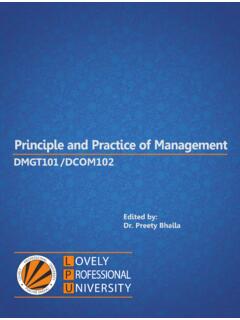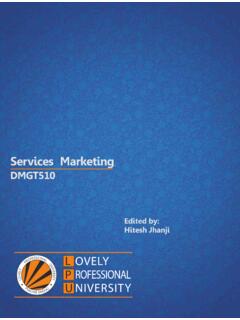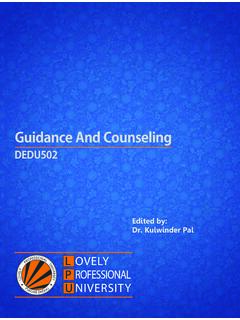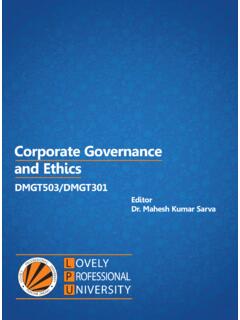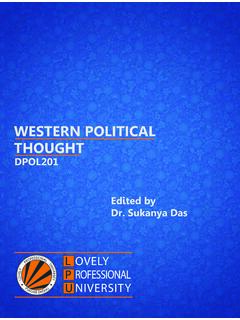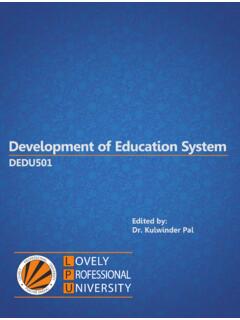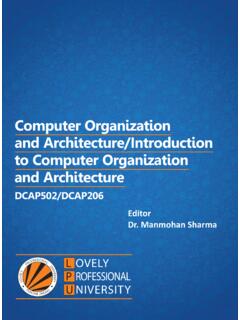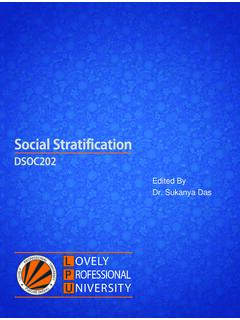Transcription of Computer Organization and Architecture/Introduction to ...
1 Computer Organizationand Architecture/Introductionto Computer Organizationand Architecture DCAP502/DCAP206 EditorDr. Manmohan Sharma OF DISTANCE EDUCATIONCOMPUTER Organization ANDARCHITECTURE/INTRODUCTION TOCOMPUTER Organization ANDARCHITECTUREE dited ByDr. Manmohan SharmaISBN: 978-93-87034-67-9 Printed byEXCEL BOOKS PRIVATE LIMITEDRegd. Office: E-77, South Ext. Part-I, Delhi-110049 Corporate Office: 1E/14, Jhandewalan Extension, New Delhi-110055 +91-8800697053, +91-011-47520129 forLovely Professional UniversityPhagwaraCONTENTSUnit 1:Review of Basics of Digital Electronics1 Anuj Sharma, Lovely Professional UniversityUnit 2:Devices Used in Digital Electronics23 Sahil Rampal, Lovely Professional UniversityUnit 3:Data Representation and Data Transfer43 Yadwinder Singh, Lovely Professional UniversityUnit 4: Computer Organization I65 Avinash Bhagat, Lovely Professional UniversityUnit 5: Computer Organization II81 Avinash Bhagat, Lovely Professional UniversityUnit 6.
2 Control Unit95 Pooja Gupta, Lovely Professional UniversityUnit 7:Central Processing Unit111 Manmohan Sharma, Lovely Professional UniversityUnit 8:Addressing Modes125 Ajay Kirani Khuswaha, Lovely Professional UniversityUnit 9: Computer Arithmetic I143 Sarabjit Kumar, Lovely Professional UniversityUnit 10: Computer Arithmetic II155 Avinash Bhagat, Lovely Professional UniversityUnit 11:Input/Output Organization165 Ajay Kumar Bansal, Lovely Professional UniversityUnit 12:Memory Organization Concepts185 Pooja Gupta, Lovely Professional UniversityUnit 13:Multiprocessors205 Manmohan Sharma, Lovely Professional UniversityUnit 14:Introduction to Parallel Processing229 Yadwinder Singh, Lovely Professional UniversitySYLLABUSC omputer Organization and Architecture/Introduction toComputer Organization and ArchitectureObjectives: The objectives of this course are.
3 To understand how computers are constructed out of a set of functional units To understand how these functional units operate, interact and communicate To understand the factors and trade-offs that affect Computer performance To understand concrete representation of data at the machine level To understand how computations are actually performed at the machine level To understand how problems expressed by humans are expressed as binary strings in a machineDCAP502 Computer Organization AND ARCHITECTURESr. No. Description 1. Review of Basics of Digital Electronics: Codes, logic gates, flip flops, registers, counters, multiplexer , demultiplexer , decoder, and encoder. 2. Integers Representation: Signed Magnitude, 1s & 2s Complement) & Real numbers (Fixed point & Floating Point representation), Register Transfer and Micro operations: Register transfer language Bus & memory transfer, logic micro operation, shift micro operation, Arithmetic Logic Shift Unit 3.
4 Basic Computer Organization : Instruction codes, Computer instructions, timing & control, instruction cycles 4. Memory reference instruction, Input/output & interrupts, Design of basic Computer Control Unit: Hardwired vs. micro programmed control unit, Control Memory, Address Sequencing, Micro program Sequencer 5. Central Processing Unit: General register Organization , stack Organization , instruction format, Addressing Modes Data transfer & manipulation, program control, RISC, CISC. 6. Introduction to Parallel Processing: Pipelining, Instruction pipeline, RISC Pipeline, Vector Processing 7. Computer Arithmetic: Addition, Subtraction, Multiplication & Division Algorithm(s), Decimal arithmetic units & Operations.
5 8. Input-Output Organization : Peripheral devices, I/O interface, data transfer schemes, program control, interrupt, DMA transfer, I/O Processor 9. Memory Organization Concepts: Cache & Virtual memory 10. Multiprocessors: Characteristics, Interconnection Structures, Interprocessor Communication and synchronization DCAP206 INTRODUCTION TO Computer Organization & ARCHITECTURESr. No. Description 1. Tools for course understanding: Awareness of ISA bus interface, a popular bus architecture used in IBM and compatible personal Computer systems. Digital Logic Circuits: Digital computers, Logic gates, Boolean Algebra, Map Simplification, Half Adder, Full Adder, Flip flops SR, JK, D, T, Edge triggered flip flops, Sequential Circuits 2.
6 Digital Components: Integrated circuits, Decoders NAND gate decoder, Encoders, Multiplexers, Demultiplexers, Registers, Shift registers, Bidirectional Register with parallel load, Binary counters, Memory Unit RAM, ROM, Types of ROMs 3. Data Representation: Number systems decimal, octal, hexadecimal, Complement (r-1) s complement, r s complement, Fixed point representation, floating point representation, Gray code, Decimal codes, alphanumeric codes, Error detection codes 4. Register Transfer and Micro-operations: Register transfer language, Register transfer, Bus and memory transfers three state bus buffers, Arithmetic micro-operations binary adder, binary adder subtractor, binary incrementer, arithmetic circuit 5.
7 Logic micro-operations and its hardware implementation, Shift micro-operations and hardware implementation, Arithmetic Logic Shift unit, Hardware description languages 6. Basic Computer Organization and Design: Instruction Codes, Stored program Organization , Computer registers, Common bus system, Computer instructions, Timing and Control, Instruction cycle, Memory reference instructions, Input output and interrupt, complete design of basic Computer 7. Central Processing Unit: General register Organization , control word, Stack Organization , register stack, memory stack, Instruction formats three address, two address, one address, zero address instructions, Addressing modes, Data transfer and manipulation, arithmetic, logical, bit manipulation, Program control, Reduced Instruction Set Computer (RISC), CISC characteristics 8.
8 Input-Output Organization : Input output interface, I/O bus and interface modules, I/O vs memory bus, Isolated vs Memory mapped I/O 9. Asynchronous data transfer, handshaking, Programmed I/O, Interrupt-initiated I/O, Priority Interrupt Daisy chaining, parallel priority, priority encoder, interrupt cycle, DMA controller and transfer 10. Memory Organization : Memory hierarchy, RAM, ROM chips, memory address map, Associative memory, Cache memory, Virtual memory, Memory management hardware 1 LOVELY PROFESSIONAL UNIVERSITYUnit 1: Review of Basics of Digital ElectronicsNotesUnit 1: Review of Basics of Digital Electronics CONTENTS Objectives Introduction Codes in Digital Electronics Classification of Binary Codes Logic Gates Summary Keywords Self Assessment Review Questions Further ReadingsObjectivesAfter studying this unit, you will be able to.
9 Discuss the codes in digital electronics List the functions of different logic gates Discuss the truth table for all the logic gatesIntroductionDigital electronics is a field of Computer science. It deals with devices that are used to carry outcomputer digital electronics, we use two-state or binary logic. The two logic states are 0 (low) and 1 (high). Computer uses binary number system for its operations. Digital electronics represents the twobinary numbers, 1 and 0, using two voltage levels in a device called a logic gate. Sometimes thetwo states can also be represented using Boolean logic functions, true or false states, or usingan on or off gates are important components of a digital circuit.
10 A logic gate takes two inputs andgenerates a single output. In this unit we will discuss about the basic logic gates and theircorresponding truth Codes in Digital ElectronicsBasically, digital data is represented, stored, and transmitted as groups of binary digits which arecalled bits. The group of bits is known as binary code. Binary codes are used in computers as theyallow computers to perform complex calculations quickly and efficiently. Binary codes are usedin financial, commercial, and industrial applications. To understand how binary codes are appliedin these fields, we first have to understand the classification of binary Classification of Binary CodesBinary codes can be represented as numbers and letters of the alphabets as well as many specialcharacters and control functions.
